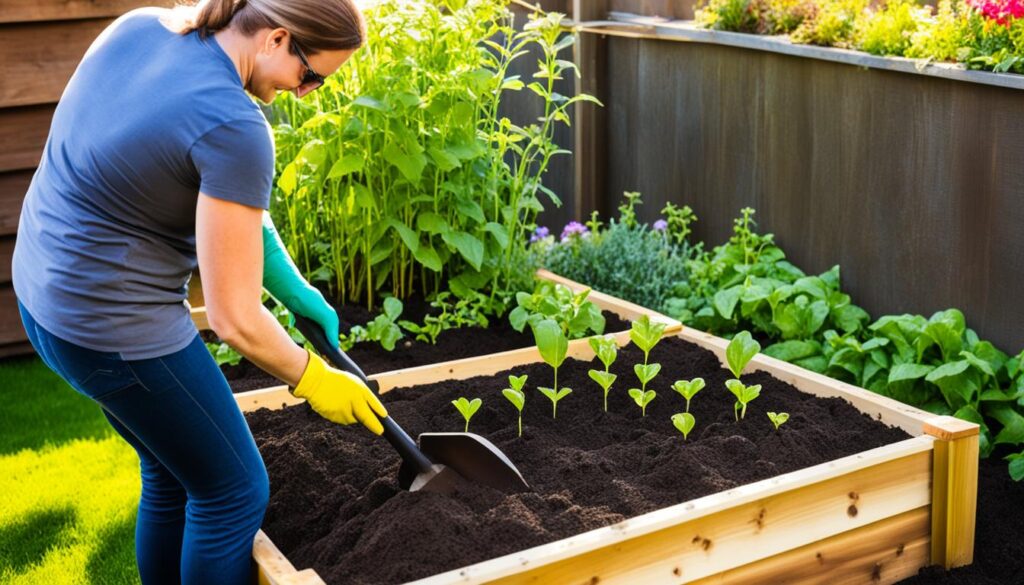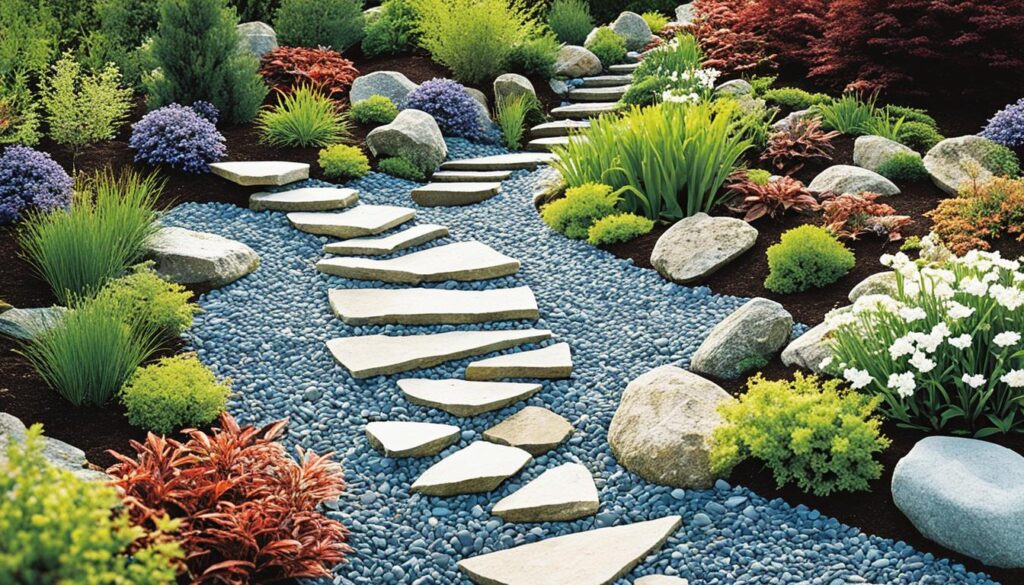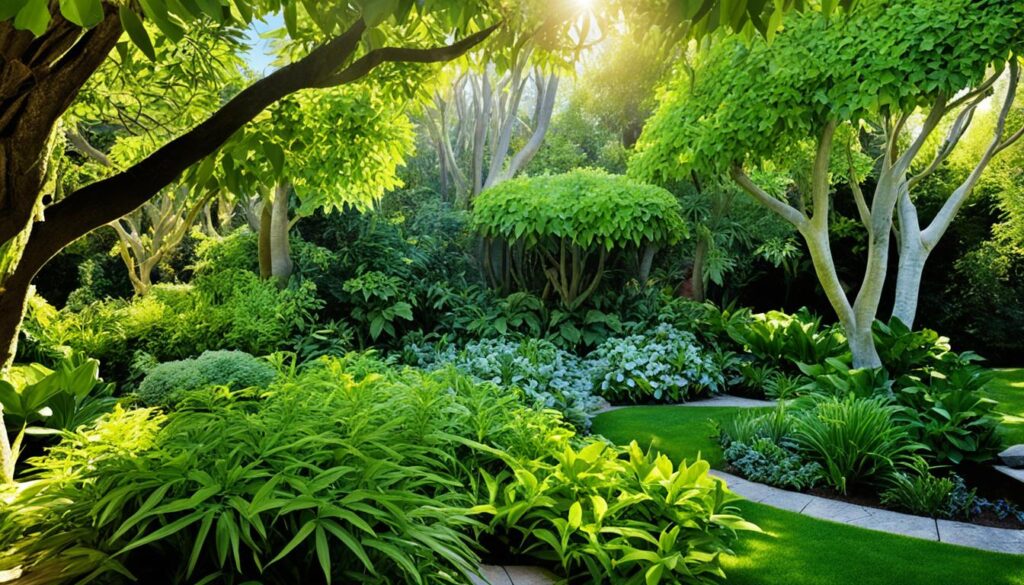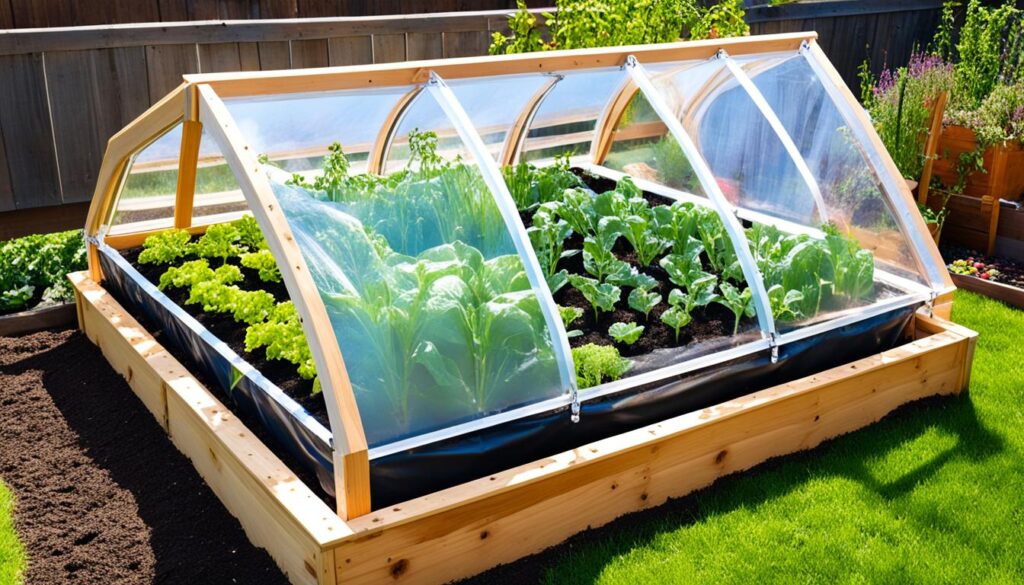As a gardener, I am always looking for ways to improve soil quality and promote healthy plant growth. That’s why I have discovered the amazing benefits of horticultural grit. You might be wondering, why use horticultural grit? Well, let me tell you.
Horticultural grit is a small, washed or treated stone particles that can greatly enhance soil structure and drainage. Made from crushed granite or limestone, this versatile material has a neutral pH and is easy to work with. Whether you are dealing with heavy clay soils or looking to create stunning rockeries and water features, horticultural grit can be a game-changer for your garden.
Key Takeaways
- Horticultural grit improves soil structure and drainage.
- It is made from crushed granite or limestone.
- Horticultural grit can be used to open up heavy clay soils.
- It is popular for decorative purposes, such as rockeries and water features.
- Choosing the right horticultural grit depends on your specific needs.
How Is Horticultural Grit Made?
Horticultural grit is made by carefully selecting and processing specific types of stone. The most commonly used materials for horticultural grit are crushed granite and limestone. These stones are chosen for their natural ability to break down into small pieces with angular edges. The angular shape is important because it provides a larger surface area, even though the individual pieces are small. This larger surface area allows for better drainage, which is crucial for healthy plant growth.
In addition to granite and limestone, quartzite stone is also used for horticultural grit, especially in decorative applications. Quartzite offers a wide range of colors, making it an attractive choice for adding visual interest to gardens, rockeries, and water features.
Once the stone has been crushed, the horticultural grit undergoes a thorough washing process. This washing serves two important purposes. Firstly, it removes any lime present in the stone, ensuring a neutral pH. This is crucial because horticultural grit needs to be compatible with different soil types and should not affect the acidity levels. Secondly, the washing process removes any impurities, ensuring that the grit is clean and free from debris.
I’m often amazed at how something as seemingly simple as crushed stone can have such a significant impact on soil structure and drainage. The careful selection of materials and the thorough washing process make horticultural grit a reliable and high-quality product that gardeners can trust.
Horticultural grit is a versatile and essential component for any gardener looking to improve soil structure and optimize plant health. Its production process ensures that it meets the necessary standards for performance and quality. With its angular shape, range of colors, and neutral pH, horticultural grit is an excellent choice for various gardening applications.
Uses of Horticultural Grit in Soil Improvement
Horticultural grit is a versatile tool for enhancing soil structure and improving drainage in your garden. Its unique properties make it an essential ingredient for optimizing plant growth and ensuring healthy, flourishing vegetation.
One of the key benefits of horticultural grit is its ability to create small pockets in the soil. The angular surfaces and variations in size and shape of the grit particles allow for better aeration and water retention, which are crucial for nourishing plants.
If you have heavy clay soils, adding horticultural grit can make a significant difference. By incorporating the grit into the soil, you can open up the clay, allowing excess water to drain away more efficiently. This prevents waterlogging, a common problem in clay soils that can lead to root rot and poor plant health.
Horticultural grit is particularly effective in preventing soil clumping in sticky clay soils. Its presence in the soil helps to break up compacted clusters, creating a looser and more friable texture that enables better root penetration and nutrient absorption.
In compost, horticultural grit serves as a valuable addition to prevent the soil from sticking together. It improves the overall structure of the compost, promoting better drainage and preventing waterlogged conditions. This, in turn, allows excess water to drain away, safeguarding plants from root rot.
If you’re creating a rockery or rock garden, horticultural grit is an excellent medium for planting. By mixing it with loam and leaf mould or coir, you can create an ideal planting mix that mimics the natural conditions found in rocky environments. This combination provides excellent drainage, while still retaining enough moisture to support plant growth.
| Benefits of Horticultural Grit in Soil Improvement | How to Use Horticultural Grit in Soil Improvement |
|---|---|
| Enhances soil structure | Mix horticultural grit with compost to improve soil structure |
| Improves soil drainage | Add horticultural grit to heavy clay soils to enhance drainage |
| Prevents soil clumping | Incorporate horticultural grit into sticky clay soils to prevent clumping |
| Allows excess water to drain away | Add horticultural grit to compost to prevent waterlogging and promote drainage |
| Ideal for rockeries and rock gardens | Mix horticultural grit with loam and leaf mould or coir for rockery planting |
Horticultural Grit for Decorative Applications
Horticultural grit is not only practical but also aesthetically pleasing, making it a popular choice for decorative use. Its versatility extends beyond soil improvement, with various applications in enhancing the visual appeal of gardens.
Decorating Pots for Cacti and Alpines
When it comes to plants that thrive in drier conditions like cacti and alpines, horticultural grit serves as an excellent decoration. By adding a layer of grit to the pots, you not only provide a visually attractive topping but also create an environment that mimics their natural habitat.
“Horticultural grit adds a touch of elegance to my cacti collection, creating a desert-like setting that highlights their unique beauty.” – Emily, Gardening Enthusiast
Moreover, horticultural grit comes into full splendor when wet. As rain or water from a watering can touches the grit, it takes on a vibrant display of colors, including maroon, white, brown, and pink. This transformation further adds to the visual appeal of your garden display, making it truly eye-catching.
Rockeries, Water Features, and Ponds
One of the most popular uses of horticultural grit in decorative landscaping is in rockeries, water features, and ponds. The textured and angular nature of the grit lends itself well to creating visually stunning rock gardens.

“In my rockery, horticultural grit beautifully complements the natural stones, giving it a ruggedly picturesque appearance reminiscent of a mountain scree.” – Mark, Landscape Designer
Water features and ponds benefit from the use of horticultural grit too. As it is sprinkled on the base or surrounding area, it adds texture and depth, enhancing the overall aesthetic appeal of these water elements.
Creating Rock Gardens and Scree Gardens
By utilizing horticultural grit, you can create captivating rock gardens and scree gardens that closely resemble the scree environments found in mountainous areas. The angular grit particles imitate the rocky terrain, while the variety of colors available allows for artistic expression in designing these miniature natural landscapes.
Incorporating different sizes and colors of horticultural grit in the design ensures a visually appealing and realistic representation of scree environments.
| Benefits of Horticultural Grit for Decorative Use |
|---|
| Enhances the visual appeal of pots holding cacti and alpines |
| Transforms into a vibrant display of colors when wet |
| Creates visually stunning rockeries, water features, and ponds |
| Allows for the creation of authentic rock gardens and scree gardens |
Choosing the Right Horticultural Grit
When it comes to horticultural grit, there is a wide range of options available on the market. Choosing the right type of grit depends on your specific gardening needs and preferences. Here are some factors to consider:
- Particle Size: The size of horticultural grit typically falls between 2-4mm for general use. However, you can select a particle size that best suits your garden and the types of plants you are growing. Smaller particles provide better drainage, while larger particles offer improved aeration.
- Composition: Horticultural grit is commonly made from crushed granite, limestone, or quartzite. Each type of grit has its own unique characteristics and appearance. Granite grit is known for its durability and angular shape, while limestone grit is prized for its neutral pH. Quartzite grit offers a range of colors, making it a popular choice for decorative purposes.
- Intended Use: Consider the specific purpose for using horticultural grit in your garden. If you need to improve soil drainage, choose a grit with better water permeability. For heavy clay soils, opt for a grit that helps open up the soil structure. If you’re using grit for ornamental purposes, select a type that enhances the overall aesthetics of your garden.
By considering these factors, you can make an informed choice and select the right horticultural grit for your gardening needs.
Comparison of Different Types of Horticultural Grit
| Type | Particle Size | Composition | Intended Use |
|---|---|---|---|
| Granite Grit | 2-4mm | Crushed granite | Improved drainage, soil aeration |
| Limestone Grit | 2-4mm | Crushed limestone | Neutral pH, soil conditioning |
| Quartzite Grit | 2-4mm | Crushed quartzite | Decorative purposes, water features |
Choosing the right horticultural grit ensures that you can optimize soil conditions, enhance plant growth, and achieve your desired garden aesthetic.

Where to Buy Horticultural Grit
Horticultural grit can be easily purchased from various sources, catering to the needs of garden enthusiasts. Whether you prefer the convenience of shopping in-person or the ease of online browsing, there are plenty of options available to satisfy your horticultural grit requirements.
1. Garden Centers
Local garden centers are a go-to destination for horticultural supplies, including grit. These centers offer a wide range of gardening products, making it convenient to find horticultural grit in different sizes and packaging options. Simply visit your nearest garden center, browse through their stock, and choose the quantity that suits your needs.
2. Online Retailers
Online retailers provide a convenient platform for purchasing horticultural grit from the comfort of your home. Websites like Corker Outdoor and Compost Direct offer a variety of horticultural grit products, ensuring you can find the perfect fit for your gardening projects. Explore their listings, compare prices, and have your chosen horticultural grit delivered directly to your doorstep.
When purchasing horticultural grit, it is crucial to prioritize quality. Look for suppliers who ensure that their grit is thoroughly washed and has a neutral pH. This ensures that the grit will effectively enhance your soil structure and drainage without negatively impacting your plants.

Image shows a display of various bags of horticultural grit, emphasizing the availability and options when purchasing this essential gardening material.
Horticultural Grit as an Alternative to Sharp Sand
When horticultural grit is not easily defined or available in certain countries, gardeners often look for alternative options. One common substitute for horticultural grit is sharp sand, which offers similar benefits and functions in improving drainage and soil aeration. Like horticultural grit, sharp sand is washed and graded, making it suitable for a variety of applications.
Sharp sand, with its coarse texture, helps create air pockets in the soil, promoting better drainage and preventing waterlogging. This is especially beneficial for plants that require well-drained soil. Moreover, sharp sand aids in soil aeration, allowing plant roots to access oxygen, essential for their growth.
For gardeners focusing on decorative applications, pea shingle and decorative stone chippings can also serve as viable alternatives to horticultural grit. These options not only provide visual appeal but also contribute to soil drainage and reduce weed growth.
While it is essential to consider the specific needs of your garden and plants, both horticultural grit and sharp sand can effectively enhance soil conditions. By selecting the alternative that aligns with your requirements and availability, you can achieve optimal results in your gardening endeavors.
How to Use Horticultural Grit in Gardening
When it comes to incorporating horticultural grit into your gardening practices, there are several effective methods to consider. Whether you want to improve soil drainage, prevent soil clumping, or enhance the aesthetic appeal of your garden, horticultural grit can be a valuable addition. Here are some practical ways to use horticultural grit in your gardening endeavors:
1. Mix with Compost for Improved Drainage
One of the simplest and most effective ways to use horticultural grit is by mixing it with compost. This combination improves the overall drainage of your soil and prevents clumping, ensuring that your plants have the ideal growing conditions. To incorporate horticultural grit, mix equal parts of compost and grit before adding it to your garden beds or pots.
2. Enhance Drainage by Adding a Layer of Grit
If you have heavy or clay-based soils that tend to retain water, adding a layer of horticultural grit can help open up the soil and improve drainage. Spread a layer of grit on top of the soil and gently dig it in, ensuring that it is evenly distributed. This method allows excess water to drain more effectively, preventing waterlogged conditions that can harm plants.
3. Create Beautiful Rockeries and Rock Gardens
Horticultural grit is an excellent choice for creating visually stunning rockeries and rock gardens. You can use it as a top dressing to add texture to the surface, or mix it with compost and other materials to create an ideal planting mix for alpines or cacti. The angular shape of the grit mimics natural scree environments found in mountainous areas, adding authenticity and beauty to your garden.
4. Use in Aquatic Planting to Prevent Soil Disturbance
If you have a pond or water feature in your garden, horticultural grit can be especially useful in aquatic planting. Adding a layer of grit to the surface of the soil around aquatic plants prevents disturbance caused by fish or water movements. This helps the plants stay rooted and ensures their overall stability and health.
5. Sprinkle on Seed Trays for Moisture Retention
When sowing seeds, especially in trays or containers, horticultural grit can be sprinkled on top of the soil to prevent drying out during germination. The grit acts as a protective barrier, helping to retain moisture and reduce evaporation. This ensures that your seeds have the necessary moisture levels to germinate successfully.
By incorporating horticultural grit into your gardening practices, you can improve soil drainage, prevent soil clumping, and add aesthetic appeal to your garden. Whether you mix it with compost, use it in rockeries, or sprinkle it on seed trays, horticultural grit is a versatile tool that enhances the health and vitality of your plants.
Tips for Using Horticultural Grit in Different Garden Settings
Horticultural grit is a versatile gardening tool that can be used in various garden settings and for specific plants. Here are some useful tips for incorporating horticultural grit into your gardening practices.
1. Alpine Planting
For alpine planting, I recommend creating a mix of equal parts compost and horticultural grit. This combination provides excellent drainage and prevents leaf rotting. Make sure to add a layer of horticultural grit on top of the planting area to further protect the plants.
2. Scree Gardens
Horticultural grit is perfect for creating scree gardens that mimic natural scree environments. The grit not only adds visual appeal but also inhibits weed germination. Spread horticultural grit generously across the garden bed to create the desired scree effect.
3. Top Dressing
Consider using horticultural grit as a top dressing for various areas in your garden. It can be applied to borders, potted plants, and hanging baskets to enhance the overall aesthetics. The grit adds texture and acts as a mulch, preventing weeds and retaining soil moisture.
4. Lawn Dressing
If you’re experiencing issues with your lawn, horticultural grit can be a helpful solution. Incorporate the grit into the soil or spread it over the surface as a lawn dressing. This will aid in soil aeration and prevent grounding with lawnmowers.
When using horticultural grit in different garden settings, it’s essential to assess the specific requirements of the plants and the overall environmental conditions. Experiment with different applications and observe how your plants respond to the addition of horticultural grit.
By implementing these tips, you’ll be able to maximize the benefits of horticultural grit and create thriving garden spaces tailored to your specific planting needs.
Conclusion
Horticultural grit is an indispensable tool for gardeners looking to improve soil quality, enhance drainage, and foster optimal plant growth. Whether you’re working with potting mixes, heavy clay soils, or aiming to add decorative elements to your garden, horticultural grit is the go-to solution. By carefully selecting the appropriate size and type of grit for your specific needs, you can achieve remarkable results in your garden.
Fortunately, acquiring horticultural grit is a straightforward process. Reputable suppliers offer a wide range of options, both online and in local garden centers. With high-quality products readily available, you can easily obtain the necessary grit to create the ideal growing environment for your plants.
Whether you’re an experienced professional or an enthusiastic hobbyist, embracing horticultural grit as part of your gardening routine is an investment in the long-term health and vitality of your plants. By incorporating this versatile material, you’ll be well on your way to reaping the benefits of improved soil structure, efficient drainage, and thriving plant growth. Get started with horticultural grit today and unlock the full potential of your garden.








